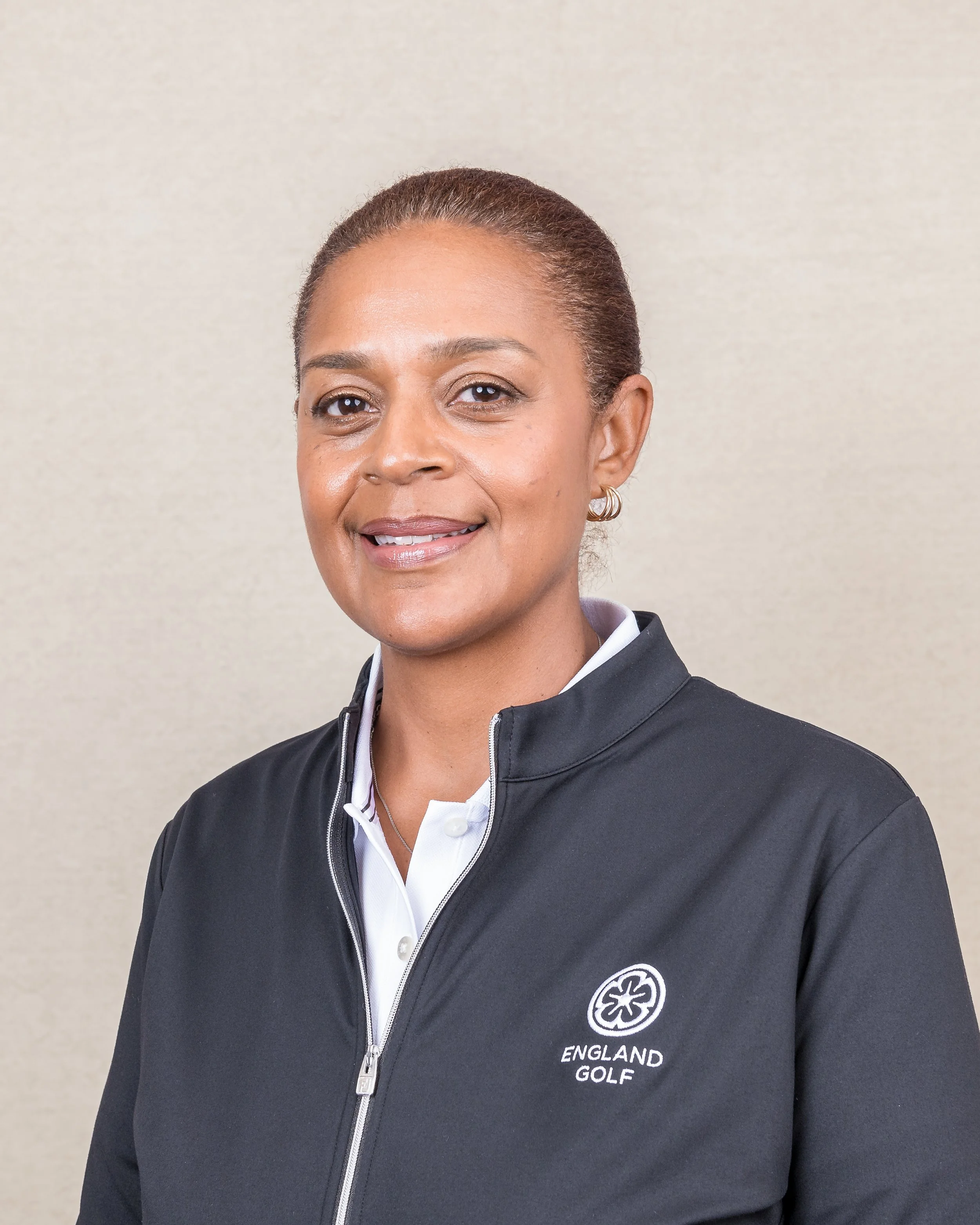
INSIGHT | PARTICIPATION PATHWAYS
Julia Regis: ‘There needs to be a genuine desire to want to change’
The renowned business consultant and leadership trainer is now an England Golf board member. She explains how embracing new ideas and being open to other points of view can open pathways to players
THESE are questions which golf has been grappling with for far too long. How do we engage younger people? How do we make the sport more inclusive? How do we bring new players in?
Despite the Covid participation boom, the numbers of women and girls joining golf clubs remains static. Diversity continues to be an issue.
So how can clubs create change and what means can they use to better engage with their communities? Let Julia Regis enlighten you.
Having been introduced to the sport by her late husband Cyrille, the former West Bromwich Albion, Coventry City and England footballer, Julia has played golf for more than12 years.
She has introduced more than 250 women into the sport through various grassroots initiatives and has helped challenge perceptions and break down barriers.
Regis is also involved with Inspiring Golf Inclusion, an initiative dedicated to empowering women and girls, focusing on those from culturally diverse backgrounds, to discover the joys of golf.
And she is a trustee of the ACE programme, which develops talent pathways to help young people of African and Caribbean heritage get into cricket.
Earlier this year, she joined the board of England Golf as a Senior Independent Director. Here she reveals five key actions which can help clubs.
1) You must embrace change
There needs to be genuine desire to want to change. It can’t be rhetoric or what the current trend or messaging might be. It must be a genuine desire from institutions involved in golf followed up by action.
When I’m asked this question, that’s always my response to golf clubs and members of boards and committees. Is there a genuine desire to want to see change happen and, if so, are you prepared to back it up with resources and thinking outside of the box?
If there is, that should be motivation enough to want to do something and to see a difference achieved.
Then it’s about what you do next and who you go to for support. It’s OK to feel, ‘I’m not sure where to start, but I know someone that can help us.’
On a personal level, I would much rather work with a club who feel a little out of their depth, but have a genuine desire, and resources attached to that desire, to see change. I’d rather that than a club that’s got the shiny statements on its website and in its policies and procedures, but yet doesn’t show change or evidence of intentional action to try and achieve change. Change should take you out of your comfort zone.
“I’d like to believe that most people would want their golf club to reflect the demographic of society now and in the future”
2) Be proactive – because you will inevitably encounter some resistance
I understand and appreciate it can be a challenge for some club committees and boards to facilitate growth in untapped areas while still taking care of the needs, wants and wishes of members.
From a governance perspective, however, part of the role of a board or committee is to look to the future. It is to ensure the business is sustainable going forwards and that there is longevity for the golf club.
It’s about getting the balance right and challenging and pushing back to existing members about why it is important to look beyond.
In my experience, if you tell the story well, if you demonstrate to your members what you’re doing and why, and demonstrate it’s not going to impact on their experience as members of a golf club, most people are fine as long it doesn’t deter them from being able to play golf how and when they want to play it. I’d like to believe that most people would want their golf club to reflect the demographic of society now and in the future.
3) If there is an issue, find out what and why
I had a conversation recently with one club who said: ‘We know we are not representative of the demographic within which we exist. We just know we’re failing miserably in reaching communities that live locally.’
It was exacerbated because there were demographics from under-represented groups who had set up societies so they could play golf, but they weren’t coming to this club – either to play or to become members.
If that is happening in your region, I would be asking lots of questions and building relationships. I’d want to know: why is this society not knocking on our door to run an event? Why are none of them converting to becoming members?
I said I could name three societies I knew that existed in the region and I could put them in touch with the captains or board members from those societies.
The rest is up to them [the club]. This is where we take positive action. The Equality Act gives us room to take positive action to try and bring equity as well as equality. I think the equity side of the legislation is something a lot of golf clubs don’t quite get their heads around.
They think of equality – we’re here, everybody can pay the same joining fee, everyone can come and experience golf in the same way – without necessarily being interested in looking at the barriers to accessing golf.
4) Make sure people get a club in their hands
The work we do with The Cyrille Regis Legacy Trust and the ACE programme is a good example of this. In the latter, in this country, and in schools, most students have access to football but not necessarily cricket.
It’s being intentional about saying, ‘we’ve seen the lack of interest and lack of opportunity for young people from African and African Caribbean communities enjoying cricket’. It’s asking, ‘why is that?’
In many schools, cricket is not an option. If you’ve never had a cricket bat put in your hands, how are you going to know that you like cricket?
It’s a similar situation with golf. One of the things we’ve done with our football project, when we have our annual golf days, is to bring some of the young people involved to act in an ambassador role.
They talk about the impact of the programme and are given a golf lesson.
It was so exciting one year when a young guy went back to his school and said, ‘can we have golf on our PE curriculum?’
A very forward-thinking headteacher liaised with the local driving range and got some golf lessons for the year group. It was phenomenal for me to see that journey.
It’s about empowering people to have the experience.
5) Do more to attract young people from underserved communities
You always remember the first time you hit the ball out of the sweet spot and how that made you feel. When somebody gets that right and launches that ball, that’s all it takes.
There are so many creative ways to engage your local community, for example, England Golf’s Community Golf Instructor initiative means club members who have gone through this programme could hold taster events in schools, local fayres, places of worship - the opportunities are endless.
The challenge going forward is how do we help facilitate the interest once it is established, especially say, a young person who has an interest in golf? If we’ve introduced them to the sport, and they like it, what happens next?
That’s where clubs could help a little bit more. We could look at bursaries or scholarships at a local, regional or perhaps even county level to support young people who show a genuine interest in golf and want to take it further.
If it’s not free, what about a concession, or a bursary within a club for young people whose parents may not be able to afford to purchase golf lessons for them? That’s just one way in which you can be intentional about moving the dial and changing the narrative.

Get golf business insights straight to your inbox
Sign up for the first look at the latest news, features, exclusive interviews and podcast episodes with our monthly newsletter


